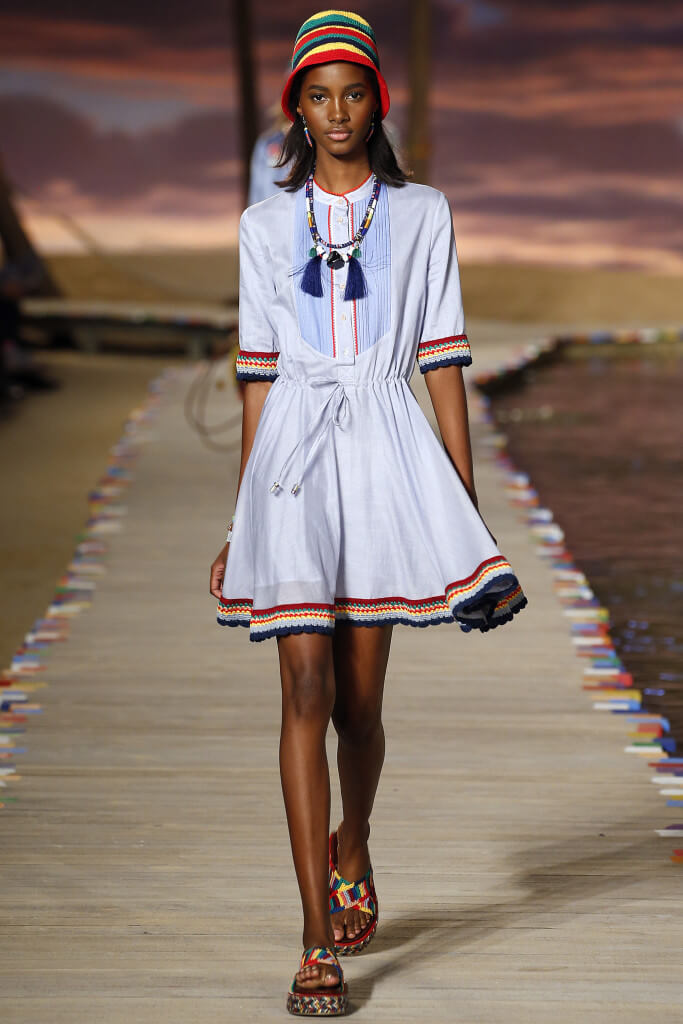Model: Tami Williams | Photo: Gianni Pucci / Indigitalimages.com
Tommy Hilfiger’s S/S 2016 collection show was this week at New York Fashion Week. While the collection was cute and definitely beachy, there was nothing ground-breaking about any of it, at least in my opinion. It seemed like he blended Cooyah with Stella Jean and sprinkled with 70’s hippie. The line was showcased a beautiful board walk beach setting, which I’ve never seen before and thought was pretty creative and set the vibe for the collection.
The line was most definitely inspired by Jamaica. When I saw a few of the pictures I, like others, was like “bullet, (insert two finga gun salute)”, then I watched the video with mixed emotions trying to decide how I felt about it. Part of me wanted to jump on the “culture appropriation” bandwagon, but when I thought about it more, I concluded that Jamaica served simply as inspiration behind the Tommy Hilfiger’s S/S 2016 collection. Here’s why:
Jamaica is an “always on” trend
Jamaica’s culture has always had an alluring feel, when it comes to mainstream culture. Jamaican culture, unfortunately to the mass has been synonymously equated to “The Caribbean” (an incorrect idea that is not completely dismissed by my fellow peeps…tell the truth!) Jamaica has always been met with open arms with a plethora of inspired artistry. Hilfiger is not the first designer, artist or brand to be inspired and he won’t be the last. Every couple of months I see something mainstream inspired by Jamaica or reggae music in general (i.e. Volkswagen, Reebok, Puma, J.Cole for BallySwiss and more)
The collection isn’t exactly being marketing towards for us
Every fashion line has a target market. Tommy Hilfiger’s S/S 2016 collection isn’t made for those who live in the Caribbean, it’s for those who vacation there. Not to mention Caribbeans aren’t buying Tommy Hilfiger in droves, even here in the states. While Hilfiger displays his admiration and was surely inspired, he’s not exactly displaying this for Caribbean based consumers, check the motto and store city listings (excluding licensing):
All Tommy Hilfiger stores reflect the brand’s “classic American cool” DNA and the mix of classic and modern influences that epitomize Tommy Hilfiger’s preppy heritage.
There are over 1,400 Tommy Hilfiger stores in over 90 countries worldwide including global flagships in seven locations: Fifth Avenue, New York (September 2009); the Champs-Élysées, Paris (November 2010); Brompton Road, London (August 2011); Omotesando, Tokyo (April 2012); Regent Street, London (November 2012); Robertson Boulevard, Los Angeles (February 2013); and Schadowstraße, Düsseldorf (August 2013). Anchor stores are located in Amsterdam, Beijing, Berlin, Bogotá, Buenos Aires, Cannes, Cologne, Dublin, Florence, Frankfurt, Hamburg, Helsinki, Hong Kong, Istanbul, London, Luxembourg, Madrid, Mexico City, Miami, Montréal, Moscow, Mumbai, Munich, New York, Osaka, Panama City, Santiago, São Paulo, Seoul, Shanghai, Singapore, Sydney, Vancouver, Vienna, and Zurich.
We set the trend, they mass produce it
Cultures are meant to transcend. With that comes trend popularity. Just because cultures become popular, it doesn’t take away from those who are at the core of each culture. Think of all the cultural trends that have have previously graced the runway and continue to pop up in a “new and fresh” look at cultural trends.
Like Lil Kim to Nicki Minaj, we want everyone to pay homage
To be welcomed and accepted into to displaying a particular culture one has to be fully immersed and in a sense “pay homage” as a right of passage to representing that culture in its most authentic forms. Since there is no definitive or explicit definition of what that it (it’s solely based on opinions) we can’t massacre Hilfiger’s design team for feelin our vibes.
Let’s not forget the Caribbean is such a blend of multiple cultures — Indian, Chinese, Dutch, Spanish and European influences are everywhere and that blend, with an island flair, is what makes our culture special. With that said, there are so many local designers based in the Caribbean and its diaspora that are much more culturally relevant, support them and continue to big up the culture elements at the mainstream level. It helps maintain our cultural legacy while we maintain our cultural authenticity.
What are your thoughts?



The show sounds like it was interesting and fun to watch, with the beach them. I do not know enough about Jamaican culture to have a true opinion on the appropriation issue. However since he is claiming American Culture, I will say that American culture is a blending of other cultures into something that is related to those cultures but also significantly different since this country is a mix of groups of people who historical (except for Native Americans) are from somewhere else. So in that sense maybe it is representative of American culture.
Interesting read. Stopping by from the Blogalicious FB page.
Thanks for stopping by!!! Agree! We tend to get possessive of cultures and origination of parts of culture. There’s a fine line between appreciation and appropriation and it’s sometimes blurred, but I wrote this more as an opinion looking at both aspects. 🙂
It’s not Jamaican. It’s Rasta. Henceforth, it’s like taking gowns worn by bishops and monks and mass-producing them for the public. If anyone should have a problem with this, it is Rastafari. They even stole the “Lion of Judah” symbol. It is a bit demeaning and iconoclastic.